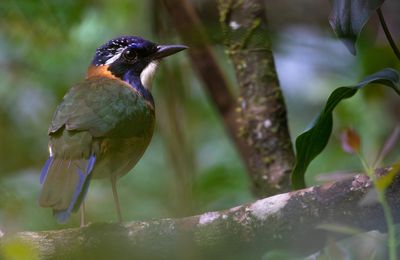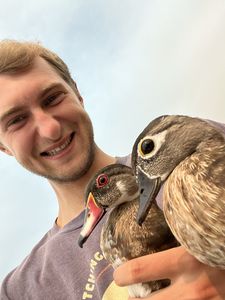Madagascar - Biodiversity in Peril | Eric Heisey | January 2023 | YVAS Program
General ·YVAS Chapter Meeting January 2023 - Madagascar: Biodiversity in PerilMadagascar may host one of the most unique biological communities on this planet. The country is widely revered amongst biologists for its vast array of endemic species; roughly 90% of Malagasy flora and fauna are found nowhere else on this planet. Perhaps the best known of these are Madagascar’s lemurs. Incredibly varied landscapes paired with lots of evolutionary time have resulted in a fantastical assortment of life forms. Truly, this country is a biological gem of our planet. When I first learned of this magical place as a toddler, I remember picturing vast swaths of virgin forest dripping with life as the haunting sounds of lemurs echoed through the moss-laden trees. It took me one car ride to realize how misguided this vision of Madagascar was. In fact, over 90% of Madagascar’s forests have been completely stripped of their trees since humans first arrived 2400 years ago. Today, forests remain intact only where they have been nationally protected, or where mountains are so steep that the clearing of the forest is impossible or impractical. Countless species native to Madagascar have already been wiped from the face of this earth, with more set to follow if human activities do not relent. Given the immense magnitude of endemism present on the world’s fourth largest island, Madagascar must be at the forefront of the world’s conservation efforts. I spent four months working in Madagascar as a research assistant and hope that I can share some of the perspective I gained in my time in the country. Madagascar is considered one of the five poorest countries in the world, something which is immediately evident upon arrival. Factors of wealth inequality, hunger, disease, and poverty which we in the United States cannot fully conceptualize compound on the dire conservation issues faced in Madagascar and are echoed across the world. How are these issues affecting the rest of the planet in a similar manner? And what can we do to help? I hope that this talk will inspire an interest in the tropical parts of the world through an introduction to some of the incredible fauna that call Madagascar home, while also providing an important perspective on the outside world that we are readily shielded from in this country. -Eric Heisey
Posted by Yakima Valley Audubon Society on Sunday, January 29, 2023

Madagascar may host one of the most unique biological communities on this planet. The country is widely revered amongst biologists for its vast array of endemic species; roughly 90% of Malagasy flora and fauna are found nowhere else on this planet. Perhaps the best known of these are Madagascar’s lemurs. Incredibly varied landscapes paired with lots of evolutionary time have resulted in a fantastical assortment of life forms. Truly, this country is a biological gem of our planet.
When I first learned of this magical place as a toddler, I remember picturing vast swaths of virgin forest dripping with life as the haunting sounds of lemurs echoed through the moss-laden trees. It took me one car ride to realize how misguided this vision of Madagascar was. In fact, over 90% of Madagascar’s forests have been completely stripped of their trees since humans first arrived 2400 years ago. Today, forests remain intact only where they have been nationally protected, or where mountains are so steep that the clearing of the forest is impossible or impractical. Countless species native to Madagascar have already been wiped from the face of this earth, with more set to follow if human activities do not relent. Given the immense magnitude of endemism present on the world’s fourth largest island, Madagascar must be at the forefront of the world’s conservation efforts.
I spent four months working in Madagascar as a research assistant and hope that I can share some of the perspective I gained in my time in the country. Madagascar is considered one of the five poorest countries in the world, something which is immediately evident upon arrival. Factors of wealth inequality, hunger, disease, and poverty which we in the United States cannot fully conceptualize compound on the dire conservation issues faced in Madagascar and are echoed across the world. How are these issues affecting the rest of the planet in a similar manner? And what can we do to help?
I hope that this talk will inspire an interest in the tropical parts of the world through an introduction to some of the incredible fauna that call Madagascar home, while also providing an important perspective on the outside world that we are readily shielded from in this country. I would be delighted if you’d join me in Yakima on January 26th, 2023!

About Eric Heisey: After growing up in the Yakima Valley enthralled with our native avifauna, Eric attended university at Western Washington University for two years before transferring to the University of Guelph in Ontario, Canada to finish his degree. While at Guelph, Eric got his feet wet in the realm of research, conducting an honors thesis on how environmental and demographic factors affect the timing of breeding of Savannah Sparrows (published in Ecology). Since graduating, Eric has been pursuing odd jobs in various locales. In Madagascar, Eric spent four months working as a research assistant studying frog responses to microclimatic stressors associated with rising temperatures as a result of a changing climate and rampant deforestation. Over the past two years he has also worked with Greater Sage-Grouse in southeastern Oregon, as a backpacking guide in Yosemite National Park, as a teaching assistant for a university field course in the Amazon rainforest of eastern Peru, and is currently the regional editor for Washington for the journal North American Birds. He has diversified in his interests over the past few years, branching out from birds and becoming interested in a wider variety of flora and fauna, though he remains an avid and active birder wherever he may be.
